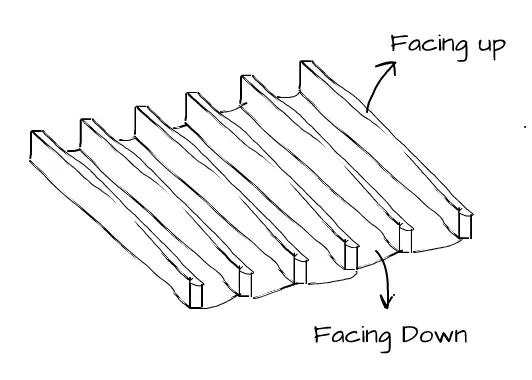Grilling season is upon us! And with it comes the frequent disassembly and reassembly of the grill to keep it spick and span and maintain it between uses.
Whether you grill with gas, charcoal, or wood pellets, the most basic form of maintenance for your grill will always be brushing and oiling the grate to keep it free from bacteria and give it protection against corrosion and rust.
Do this on a brand-new grill, or for the first time in the season, and you may find yourself confronted with the following riddle: Which side of the grill grate goes up? A good question, and one that warrants increased attention from the griller.
The long and the short of it, as with any good question, is “it depends.” But we’re not going to leave you hanging that easily, and you came here for specific advice. So let’s get straight to it:
On most grill grates, the side that’s flat and wide should go up for maximum contact with the food. Some grates are made of rods, others have V-shaped grooves, and third ones have rails, all of which should point upward.
It’s important to orient the grill grate right. Doing so not only keeps steaks, chops, and fillets from sticking, but also reduces flare-ups by catching the fats and the juices that melt and drip off the meat as it sizzles.
When in doubt, refer to the manual for the make and model of your grill. Ideally, the it should contain all the instructions you need for proper assembly. That said, these instructions often get lost or misplaced, and many assume you have innate knowledge of how to orient the grate.
(If you can’t remember where you put the manual for your grill, try looking up the make and model on the manufacturer’s website in search for a scanned version of it.)
Orientation of Cast Iron and Carbon Steel Grates
If your grill’s grate is made out of cast iron or carbon steel, which you will recognize by its dark-gray color, porous surface, and weight, it’s likely that the grate has legs on the side that should be facing down. This is the most reliable indicator of which side should be facing toward the burners, and which toward the lid.
Suppose that there are no legs on the grate, so you can’t use them as an indicator. In such a case, look closely at the two sides of the grate and see which side is flatter. The flat, wide side should face up for maximum contact with the food; the narrow, pointed side should face down.
Some find this counterintuitive, but there’s good reason behind it: The grate is as much about transferring heat to your food as it is about giving you a surface on which to place it. More contact means more heat, which means fast, even grilling.
Orientation of Aluminum and Stainless Steel Grates
Aluminum and stainless steel grates, which you can recognize by their gray color and metallic sheen, are different. Unlike iron, which must be melted and cast to form a grate, steel is workable. So manufacturers will do more with steel grates than with their iron counterparts.
Steel-Rod Grill Grates

Some grates are an array of rods that have been welded together. There’s a side with long rods welded on a side with short rods that form a frame; the one with the long rods should be always pointing upward.
V-Groove Grill Grates

Some grills are equipped with a grate with V-shaped grooves. Like the letter “V,” the grooves should face upward. The grate is slowed, with an incline to one side, to catch the fat and juices that drip off the meat during cooking and collect them in a trough.
This type of grates are particularly good at collecting drippings in the trough. The choice is yours: you can baste your meat with those drippings as it sizzles on the grill, or you can just leave them there and dispose of them after you’re done cooking.
Rail Grill Grates

Although few grills come from the factory with rail grates, there are a number of aftermarket manufacturers that produce them. Such grates have a side with tall rails and a flat side with holes that allow hot air to rise from the burners.
If your grill has rail grates, there is no right or wrong side; each is designed to give you a different grilling experience. The rails, like the wire rack on a broiler pan, allow the meat to sear and promote browning. When you flip the grate, you get a flat surface with nice, even heat.
Final Words of Advice
On some grills, you can remove and put back the grate simply by lifting it (or sliding it).
Other grills metal hinges that connect one side of the grate to the grill unit. Open these hinges all the way, slowly and carefully, so that no parts get caught when you remove the grate for cleaning. Nine times out of ten, you want to hear and see them click into place.
In case you didn’t mount the grate properly, but you only found that out after firing up the grill, let it cool down before handling it lest you want to burn your hands. These things can accumulate a lot of heat, and not all grilling mitts give you adequate protection.
You have an incentive to get this right: With the grates face-down, your food won’t cook as quickly and as evenly because heat doesn’t get transferred to it as designed by the engineer of the appliance.
Most of the time, it’s the flat side that goes up and the pointed side that’s facing the burners. Unless, that is, you’re cooking on V-grooved grates or rail grates.

